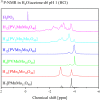Spectroscopic, Crystallographic, and Electrochemical Study of Different Manganese(II)-Substituted Keggin-Type Phosphomolybdates
- PMID: 35731027
- PMCID: PMC9546069
- DOI: 10.1002/chem.202201084
Spectroscopic, Crystallographic, and Electrochemical Study of Different Manganese(II)-Substituted Keggin-Type Phosphomolybdates
Abstract
Adjusting the RedOx activity of polyoxometalate catalysts is a key challenge for the catalysis of selective oxidation reactions. For this purpose, the possibility of influencing the RedOx potential by the introduction of an additional RedOx-active element was investigated. Thereby, Keggin-type polyoxometalates (POMs) with up to three different elements in the metal framework were created. An advanced and reproducible synthetic procedure to incorporate MnII and additionally VV into Keggin-type heteropolyacids alongside comprehensive characterization of the new molecules is presented. The success of our syntheses was confirmed by vibrational spectroscopy (IR and Raman) and elemental analysis. Furthermore, the new compounds were analyzed by NMR spectroscopy to investigate the characteristics of the POMs in solution. The structures of successfully crystalized compounds were determined by single-crystal X-ray diffraction. Moreover, all synthesized compounds were characterized using UV/Vis spectroscopy and electrochemical analysis to get further insights into the electronic transfer processes and redox potentials.
Keywords: NMR spectroscopy; crystallography; electrochemistry; polyoxometalates; redox active elements.
© 2022 The Authors. Chemistry - A European Journal published by Wiley-VCH GmbH.
Conflict of interest statement
The authors declare no conflict of interest.
Figures













Similar articles
-
Surface and bulk aspects of mixed oxide catalytic nanoparticles: oxidation and dehydration of CH(3)OH by polyoxometallates.J Am Chem Soc. 2009 Oct 28;131(42):15544-54. doi: 10.1021/ja904957d. J Am Chem Soc. 2009. PMID: 19807071
-
Preparation, structural characterization, and ion-exchange properties of two new zeolite-like 3D frameworks constructed by ε-Keggin-type polyoxometalates with binding metal ions, H11.4[ZnMo12O40Zn2]1.5- and H7.5[Mn0.2Mo12O40Mn2]2.1-.Inorg Chem. 2014 Jul 21;53(14):7309-18. doi: 10.1021/ic500630h. Epub 2014 Jul 9. Inorg Chem. 2014. PMID: 25005055
-
Zr(IV)-monosubstituted Keggin-type dimeric polyoxometalates: synthesis, characterization, catalysis of H2O2-based oxidations, and theoretical study.Inorg Chem. 2006 Sep 4;45(18):7224-34. doi: 10.1021/ic0608142. Inorg Chem. 2006. PMID: 16933923
-
The Cluster Design and Redox Behavior Characterization of Polyoxometalates for Redox Flow Batteries.Chem Asian J. 2022 Dec 14;17(24):e202200950. doi: 10.1002/asia.202200950. Epub 2022 Nov 14. Chem Asian J. 2022. PMID: 36316275 Review.
-
H8 [PV5 Mo7 O40 ] - A Unique Polyoxometalate for Acid and RedOx Catalysis: Synthesis, Characterization, and Modern Applications in Green Chemical Processes.ChemSusChem. 2023 Aug 21;16(16):e202300072. doi: 10.1002/cssc.202300072. Epub 2023 Aug 1. ChemSusChem. 2023. PMID: 37129162 Review.
Cited by
-
Two New Compounds Based on Bi-Capped Keggin Polyoxoanions and Cu-Bpy Cations Contain Both CuII and CuI Complexes: Synthesis, Characterization and Properties.Molecules. 2023 Jun 12;28(12):4706. doi: 10.3390/molecules28124706. Molecules. 2023. PMID: 37375262 Free PMC article.
References
-
- Gumerova N. I., Rompel A., Nat. Chem. Rev. 2018, 2, 1–20.
-
- Lu F., Wang M., Li N., Tang B., Chem. Eur. J. 2021, 27, 6422–6434. - PubMed
-
- Yang L., Lei J., Fan J. M., Yuan R. M., Sen Zheng M., Chen J. J., Dong Q. F., Adv. Mater. 2021, 33, 1–25. - PubMed
-
- Song Y. F., Tsunashima R., Chem. Soc. Rev. 2012, 41, 7384–7402. - PubMed
-
- Neumann R., Inorg. Chem. 2010, 49, 3594–3601. - PubMed
LinkOut - more resources
Full Text Sources

